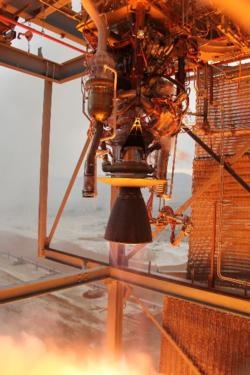Fri, Apr 17, 2015
Will Boost New Shepard Suborbital Flight
Blue Origin recently completed acceptance testing of its BE-3 rocket engine, the first new hydrogen engine to be developed in the United States in more than a decade. The 110,000-lbf BE-3 will power Blue Origin’s New Shepard suborbital system, and later, will be modified for upper stage applications.

"The BE-3 has now been fired for more than 30,000 seconds over the course of 450 tests,” said Jeff Bezos, Blue Origin founder. “We test, learn, refine and then test again to push our engines. The Blue Origin team did an outstanding job exploring the corners of what the BE-3 can do and soon we’ll put it to the ultimate test of flight.”
The BE-3 can be continuously throttled between 110,000-lbf and 20,000-lbf thrust, a key capability for vertical takeoff and vertical landing vehicles. The testing profile included multiple mission duty cycles, deep throttling and off-nominal test points.
“Liquid hydrogen is challenging, deep throttling is challenging and reusability is challenging," said Bezos. “This engine has all three. The rewards are highest performance, vertical landing even with a single-engine vehicle and low cost. And, as a future upper stage engine, hydrogen greatly increases payload capabilities.”
The BE-3 engine was designed and fabricated at Blue Origin’s design, development and production facility in Kent, Wash. Full-engine testing was conducted at the company’s facilities in West Texas, while earlier combustion chamber testing was completed at NASA’s Stennis Space Center in Mississippi.
The BE-3 is the third generation of Blue Origin-developed engines. The fourth-generation BE-4 uses liquid oxygen and liquefied natural gas (LNG) to produce 550,000-lbf thrust at sea level. Under development since 2012, the BE-4 provides the lowest cost and fastest production path to power the nation’s access to space. Selected by United Launch Alliance to serve as the primary propulsion provider for its Next Generation Launch System, Blue Origin is developing the BE-4 as an integrated part of America’s newest launch vehicle.
(Image provided by Blue Origin)
More News
Aero Linx: Model Aeronautical Association of Australia MAAA clubs are about fun flying, camaraderie and community. For over 75 years, the MAAA has been Australia’s largest fl>[...]
Touchdown Zone Lighting Two rows of transverse light bars located symmetrically about the runway centerline normally at 100 foot intervals. The basic system extends 3,000 feet alon>[...]
“Discovery and innovation are central to our mission at Virgin Galactic. We’re excited to build on our successful record of facilitating scientific experiments in subor>[...]
How To Get A Story On Aero-TV News/Feature Programming How do I submit a story idea or lead to Aero-TV? If you would like to submit a story idea or lead, please contact Jim Campbel>[...]
Student Pilot Reported That During Rotation, “All Of A Sudden The Back Of The Plane Kicked To The Right..." Analysis: The student pilot reported that during rotation, “>[...]
 ANN's Daily Aero-Linx (05.02.24)
ANN's Daily Aero-Linx (05.02.24) ANN's Daily Aero-Term (05.02.24): Touchdown Zone Lighting
ANN's Daily Aero-Term (05.02.24): Touchdown Zone Lighting Aero-News: Quote of the Day (05.02.24)
Aero-News: Quote of the Day (05.02.24) ANN FAQ: Contributing To Aero-TV
ANN FAQ: Contributing To Aero-TV NTSB Final Report: Cirrus Design Corp SR20
NTSB Final Report: Cirrus Design Corp SR20



